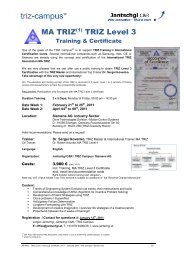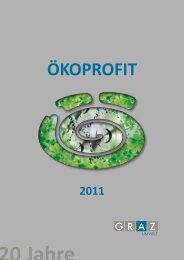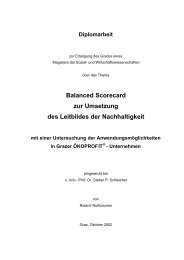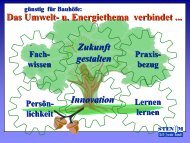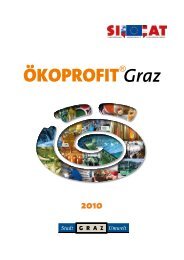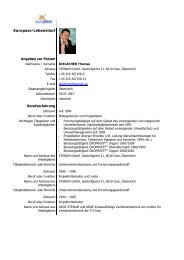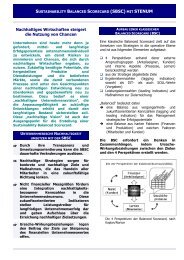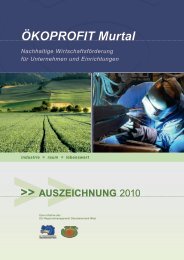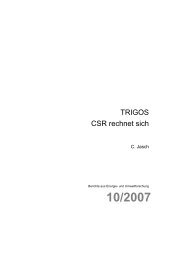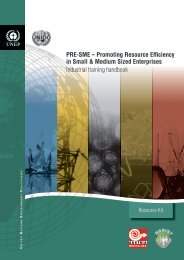- Seite 3 und 4:
ZERMEG II - Zero emission retrofitt
- Seite 5 und 6:
VorwortDer vorliegende Bericht doku
- Seite 7 und 8:
Inhaltsverzeichnis1 Kurzfassung ___
- Seite 9 und 10:
10.1.2 Kontinuierliche Reinigung de
- Seite 11:
16.1.7 Optimierung des Beizvorgangs
- Seite 14 und 15:
2 AbstractZERMEG II is the follow u
- Seite 16 und 17:
ZERMEG-Grid Fallstudie Anodisierans
- Seite 18 und 19:
Bei dem Drahthersteller wurde die S
- Seite 20 und 21:
4 Extended abstractZERMEG II is the
- Seite 22 und 23:
New results from literature researc
- Seite 24 und 25:
During the “Mission to consult GT
- Seite 26 und 27:
Weitgehender Verzicht auf Roh-, Arb
- Seite 28 und 29:
Die betriebsinterne Analyse des eig
- Seite 30 und 31:
6 Projektziele von ZERMEG II6.1 Sch
- Seite 32 und 33:
Daher sollten in ZERMEG II zunächs
- Seite 34 und 35:
Die Partner betreiben insgesamt 6 v
- Seite 36 und 37:
Lässt die Wirkung einer Beize nach
- Seite 38 und 39:
DekapierenDekapieren ist eine Zwisc
- Seite 40 und 41:
Phosphorsäure wird für bestimmte
- Seite 42 und 43:
7.2.2.3 BeizentfetterWie bereits er
- Seite 44 und 45:
In nachfolgender Abbildung 3 ist f
- Seite 46 und 47:
Zusammenfassend kann man sagen, das
- Seite 48 und 49:
8 Entfetten8.1 Allgemeines über di
- Seite 50 und 51:
Folgende Parameter beeinflussen den
- Seite 52 und 53:
Abbildung 6: Synergismus Builder/Te
- Seite 54 und 55:
Anionen-Tenside unterteilt man weit
- Seite 56 und 57:
Daimler Chrysler in Stuttgart reagi
- Seite 58 und 59:
Eine weitest mögliche Verringerung
- Seite 60 und 61:
Anlagen zur Entfettung mit Lösungs
- Seite 62 und 63:
Tabelle 11: Abscheideeffizienz und
- Seite 64 und 65:
100959085Prozentuelle Entfernung vo
- Seite 66 und 67:
der Wertstoffverluste und der Schwe
- Seite 68 und 69:
MetallVerfahrenUranBiolaugung/Bioso
- Seite 70 und 71:
9.4.2 Biologische RegenerationEntfe
- Seite 72 und 73:
Abbildung 12: Funktionsprinzip der
- Seite 74 und 75:
Die wässrige Losung, die das zu is
- Seite 76 und 77:
Abbildung 14: Filterprinzip und Bau
- Seite 78 und 79:
Hochleistungskerzen werden jedoch a
- Seite 80 und 81:
Abbildung 18: Filterprinzip und Bau
- Seite 82 und 83:
Zum Regenerieren des Ionentauscherh
- Seite 84 und 85:
Ein weiterer Unterschied liegt in d
- Seite 86 und 87:
9.4.13.2 Mikrofiltration 38Membrane
- Seite 88 und 89:
9.4.13.4 NanofiltrationMembranen zu
- Seite 90 und 91:
Die Vor- und Hauptentfettung wird
- Seite 92 und 93:
stabil angesehen werden können. Ko
- Seite 94 und 95:
Schranken 44 sind der Diffusionsdia
- Seite 96 und 97:
Abbildung 26: Blockfließbild: Proz
- Seite 98 und 99:
Es können bei abwechselnder Beschi
- Seite 100 und 101:
9.4.15.1 ÖlabscheiderDurch einen
- Seite 102 und 103:
Verdampfer werden hauptsächlich im
- Seite 104 und 105:
Abbildung 29: Schematische Darstell
- Seite 106 und 107:
10 Kombinationen von Trenntechnolog
- Seite 108 und 109:
Weiters sollte der Gehalt waschakti
- Seite 110 und 111:
10.1.4 Kombination Membrantrennverf
- Seite 112 und 113:
Das erhaltene Permeat wird in die S
- Seite 114 und 115:
Vorteile, durch den Einsatz einer k
- Seite 116 und 117:
Ergebnisse:Nachfolgende Abbildungen
- Seite 118 und 119:
Die Schäden der Verzinkungsfehler
- Seite 120 und 121:
Das Pyrohydrolyse-Verfahren basiert
- Seite 122 und 123:
In der Literatur werden als Einsatz
- Seite 124 und 125:
Für andere Grundwerkstoffe als Eis
- Seite 126 und 127:
Das Kristallisationsverfahren kann
- Seite 128 und 129:
Das schwefelsaure Raffinat kann dur
- Seite 130 und 131:
Lösung zwischen Anode und Kationen
- Seite 132 und 133:
Abbildung 40: Kombination von Trenn
- Seite 134 und 135:
Die Sulfat-Reoxidation erfolgt unab
- Seite 136 und 137:
Abtrennung störender Kationen mitt
- Seite 138 und 139:
11 SpülenDas Spülen hat die Aufga
- Seite 140 und 141:
Abbildung 44: Verfahrensprinzip der
- Seite 142 und 143:
13 Modellbildung13.1 Das QUICK-Rech
- Seite 144 und 145:
Abbildung 47: Vergleich zweier Spü
- Seite 146 und 147:
Weitere Parameter, die zu diesem Ze
- Seite 148 und 149:
ergibt sich ein realistischer Wert
- Seite 150 und 151:
Berechnung: Es wird ein semiempiris
- Seite 152 und 153:
14 Die Bewertung galvanischer Proze
- Seite 154 und 155:
Als Best Verfügbare Technologien w
- Seite 156 und 157:
Das Erreichen einer möglichst lang
- Seite 158 und 159:
Das Beispiel aus Abbildung 51 zeigt
- Seite 160 und 161:
15 Der erweiterte Optimierungsansat
- Seite 162 und 163:
Als Instrumente wurden folgende Unt
- Seite 164 und 165:
Bei schneller Abkühlungsgeschwindi
- Seite 166 und 167:
Tabelle 28: Inhaltsstoffe der Alts
- Seite 168 und 169:
Gründe hierfür sind die Wirkung1.
- Seite 170 und 171:
Durch die Bildung einer mehrstufige
- Seite 172 und 173:
Die Tauchsonde für die Spektroskop
- Seite 174 und 175:
Aus den Grafiken ist ersichtlich, d
- Seite 176 und 177:
Abbildung 62: Fotos des Versuchsauf
- Seite 178 und 179:
Es wurde versucht, die Bildung der
- Seite 180 und 181:
Der Grund ist der, dass für unters
- Seite 182 und 183:
Chargen, Schichten oder noch größ
- Seite 184 und 185:
Der Fehler zwischen gravimetrischer
- Seite 186 und 187:
20Beizabtrag bei Fe 50g/l und HCl 1
- Seite 188 und 189:
Wird der Inhibitor 2 verwendet, so
- Seite 190 und 191:
Für die Betrachtung der Mittelwert
- Seite 192 und 193:
Minuten um 50 % bei Fe 50 g/l und u
- Seite 194 und 195:
Die Ergebnisse der Laborversuche si
- Seite 196 und 197:
Abbildung 85: Bestimmung der Bleime
- Seite 198 und 199:
In einer Elektrolysezelle kann sowo
- Seite 200 und 201:
der Ermittlung der Dichte der Bäde
- Seite 202 und 203:
Tabelle 33: Abscheidegrad Feststoff
- Seite 204 und 205:
Diese Verfahrensvariante würde zum
- Seite 206 und 207:
Zur Erzielung einer definierten Obe
- Seite 208 und 209: 17 Präsentationen, Publikationen,
- Seite 210 und 211: 18 Auswertung der FallstudienEs war
- Seite 212 und 213: Arbeitsstoffen. Gleichzeitig wird d
- Seite 214 und 215: Im Rahmen dieses Projektes konnten
- Seite 216 und 217: 20 LiteraturAG BREF Oberflächentec
- Seite 218 und 219: Internet-Adressen:http://dc2.uni-bi
- Seite 220 und 221: 21 AbbildungenAbbildung 1: ZERMEG-G
- Seite 222 und 223: Abbildung 60: Versuchsaufbau der Be
- Seite 224 und 225: 22 TabellenTabelle 1: Die ZERMEG-Me
- Seite 226 und 227: 23 AnhangAuswahlmatrix zur Selektio
- Seite 228 und 229: Beizmittel > .WerkstoffALLGEMEINESE
- Seite 230 und 231: Beizmittel > .WerkstoffEisen, Stahl
- Seite 232 und 233: Beizmittel > .WerkstoffKupfer / met
- Seite 234 und 235: WerkstoffBeizmittel > .organische B
- Seite 236 und 237: WerkstoffBeizmittel > .organische B
- Seite 238 und 239: 1 AbstractThe authors have develope
- Seite 240 und 241: Water consumption is very high in t
- Seite 242 und 243: The following points summarise the
- Seite 244 und 245: 5 Features of common galvanising pr
- Seite 246 und 247: 5.6 RinsingRinsing is a process ste
- Seite 248 und 249: Company analyses in Cleaner Product
- Seite 250 und 251: The internal analysis of the galvan
- Seite 252 und 253: insing degreasingFor each of these
- Seite 254 und 255: Fig. 3: The anodising plant of A. H
- Seite 256 und 257: The results of the optimisation are
- Seite 260 und 261: Now, once a month the concentration
- Seite 262 und 263: 1 Pool of the copper bath2 Copper e
- Seite 264 und 265: Open fileCover sheetEDIT EXISTING P
- Seite 266 und 267: 9 ConclusionsThe method of ZERMEG w
- Seite 268 und 269: To disseminate the approach of ZERM
- Seite 270 und 271: 11 ReferencesAG BREF Oberflächente
- Seite 272 und 273: aths are described in details showi
- Seite 274 und 275: ZERMEGZero Emission Retrofitting Me
- Seite 276 und 277: Flow sheetHCl Water H 3PO 4SoapEtch
- Seite 278 und 279: 1Literature3Incorporating and using
- Seite 280 und 281: Reduction of water usage at ananodi



